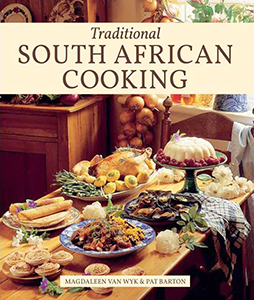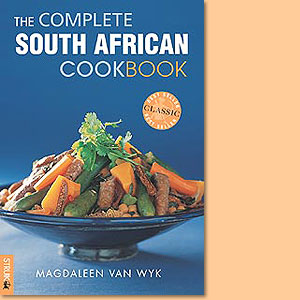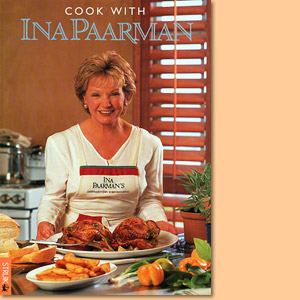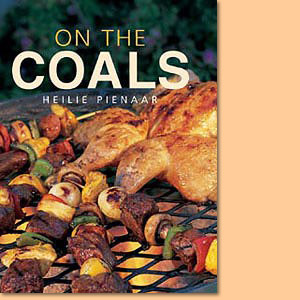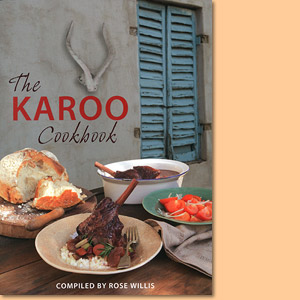Traditional South African Cooking, by Pat Barton and Magdaleen van Wyk
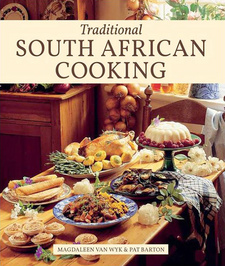
Traditional South African Cooking, by Pat Barton and Magdaleen van Wyk. Random House Struik Lifestyle. 5th revised edition. Cape Town, South Africa 2014. ISBN 9781770074071 / ISBN 978-1-77007-407-1
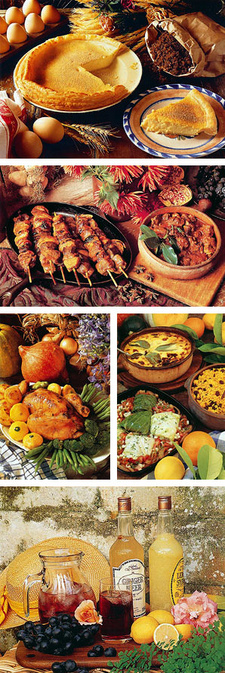
These are images taken from Pat Barton's and Magdaleen van Wyk's splendid cookbook Traditional South African Cooking (Random House Struik Lifestyle)
Pat Barton and Magdaleen van Wyk are seasoned cookbook authors. Their most popular cookbook Traditional South African Cooking has been revised and published over several editions.
While no dish can be said to be peculiarly South African, the subtle adaptation of these 'imported' recipes in the addition of local ingredients and the introduction of innovative cooking methods have made for an original cuisine. It's a culinary repertoire inextricably bound up with our history: from the contributions of the earliest settlers at the Cape and the experimentation with game of stock farmers who trekked into the interior; to the influence of the French, German and British immigrants as well as that of Indian workers and slaves from the East, particularly the Malays, and immigrants from African Countries like Angola and Mozambique. Immigrants from Portugal and Greece have also made their mark. The first Dutch settlers brought with them recipes and cooking methods that are still with us today; the Dutch habit of serving vegetables dotted with butter and sprinkled with grated nutmeg, for instance. Their way of cooking meat with herbs and spices has also become a time-honoured tradition here. The chief contribution of the French Huguenots lay in their improvement of viticulture and the production of fruit. They refined the production of raisins, for instance, and their method for making confitures from the local fruit survives in the present-day preserves which we call konfyt. The French also passed on their ways of dealing with offal. The German settlers passed on a love for spicy wurst, which we still see today in the wide variety of boerewors recipes, and their hearty casseroles. British settlers introduced roast meats, particularly beef, which is still the preferred main Sunday meal at many South African tables, served with roast potatoes and Yorkshire pudding. Their savoury pies are legend, as are the filling hot puddings like roly poly, rice pudding and steamed puddings. Perhaps the greatest contribution was made by the Malay slaves who were brought to the Cape from the East in the late 17th century. We acquired from them the liking for combining sweet and sour that is so characteristic of South African cooking, as well as the spicy sauces, curries, chutneys, blatjangs and atjars that are so indicative of our cuisine. Many of the old recipes which have become so much a part of South African cooking are included here. There are also recipes that are new classics - if that is not a contradiction in terms - which have become part of our repertoire within the last 40 years or so, but which we have adopted with such alacrity that they feel right at home with those that have been around for centuries. The recipes have been modernized, in the sense that the present-day utensils and appliances are used - the microwave oven, for instance, where suitable - and that quantities for preserves, pickles and chutneys are smaller to allow for the fact that the modern cook is generally short of time. Another modernizing feature is that metric measures are provided for all the recipes. One of the problems we encountered when converting and testing the old recipes was the fact that imperial measures and metric ones just do not correspond. We felt, therefore, that giving metric measures would be more useful, as most measuring implements are now metric. If you still prefer to use imperial measures, a table of volume conversions (teaspoon, tablespoon and cup to millilitre/litre) is provided below. Ingredients listed in kilograms and grams in the recipes should be weighed on kitchen scales for the best results. We hope that you will enjoy using the recipes in this book, and that they will provide pleasure for years to come.
This is an extract from: Traditional South African Cooking, by Pat Barton and Magdaleen van Wyk
Title: Traditional South African Cooking
Authors: Pat Barton; Magdaleen van Wyk
Publisher: Random House Struik
Imprint: Lifestyle
5th revised edition. Cape Town, South Africa 2014
ISBN 9781770074071 / ISBN 978-1-77007-407-1
Softcover, 21 x 28 cm, 144 pages, 80 colour photos
Barton, Pat und van Wyk, Magdaleen im Namibiana-Buchangebot
Traditional South African Cooking
The art of South African traditional cuisine is a unique blend of the culinary art of many different cultures.
The Complete South African Cookbook
The Complete South African Cookbook offers more than 650 basic and easy-to-prepare South African recipes along with many tempting variations.
Weitere Buchempfehlungen
Cook with Ina Paarman
Cook with Ina Paarman changes cooking to a rewarding pastime with over 200 South African recipes.
On the Coals
On the Coals is an innovative new collection of South African braai recipes and ideas for the keen outdoor cook.
The Karoo Cookbook
The Karoo Cookbook is filled with delicious recipes that have been handed down from generation to generation.

